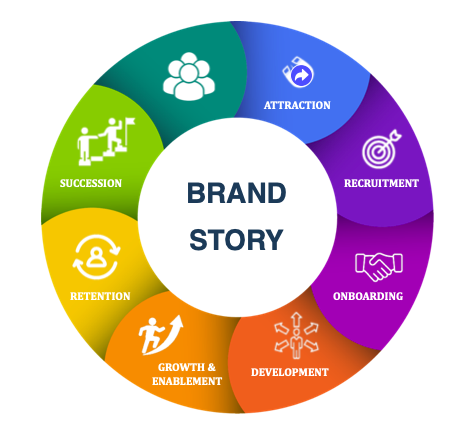
So, you’ve been working on your organization’s brand. Hopefully it has been an engaging and eye-opening activity, not only for you but also for others inside the organization who have played a role in the effort.
Now the re-brand is coming to an end. Months have passed. Dozens of people both inside and outside the organization have contributed their insights to the new brand—the new market-facing story—you’re poised to share. The board has given its stamp of approval. The ELT, and even more so the Marketing team are now keen to put that story to work, creating campaigns and experiences that will hit the mark with their customers. Oh, and their colleagues. Right?
When the fanfare and confetti of product launches and all-company announcements fade, so does employee engagement. For many companies, brand development often fails to pull the thread all the way through to the very people who should be their biggest brand ambassadors– the employees within.
Colleagues Aren’t Customers
When it comes to brand-building, employees outside of Marketing can feel like the children left behind as the rest of the family continues their vacation, watching the van pull away from the rest stop without them. This is true even when the organization understands the value that broader buy-in can deliver—and attempts to realize it.
About that attempt: In many mature organizations, Marketing makes a concerted effort to work with Human Resources to internalize the brand. “Internalizing the brand” means more than soliciting advice and securing approval. It means “creating a sense of identification with the story.” The practical benefits of doing include fostering shared sense of unity and purpose, enlisting employees as informal brand marketers, supporting a more positive customer experience, and much more.
The point of this article isn’t to make the case for internalizing the brand. If you agree with the premise, then great, I’m writing for you and we can turn to the matter of how.
The Big Moment Passes
Does this experience sound familiar: Your organization’s staff is assembled, dozens or maybe hundreds strong. Your CEO (assuming that’s not you) talks about the strategic importance of the newly crated or repointed brand and game-changing benefits it will deliver. Next, your CMO (assuming that’s not you) talks about all the (thoughtful, rigorous, inclusive) effort that went into crafting the story—including all of the periodic updates and channels for input made available to staff.
And then comes the reveal. Congratulations, it looks as if your team has done a good job. The enthusiasm and goodwill are palpable.
Yet weeks later, you find yourself asking, “And so?” You realize that while the story may truly inspire in the moment, getting people to adopt it as their own doesn’t happen overnight, or through the simple act of repetition.
Culture Makes Stories Sticky
Turns out that for the story to stick, it needs to graft onto your organization’s culture. As brand expert David Salyers points out, “The brand is the portal through which a customer views the story and the culture is the portal through which the employee views the story.” So while a story can transform a culture, it first needs to be able to attach to it.
“Grafting” is an apt term. It implies time and care. A process, not an event. Not only a baton hand-off between Marketing and Human Resources but also s willingness to invest in longer-term strategies that drive brand engagement and cultural change.1
Keys to Stickiness
Internalizing the brand story involves three key ingredients: Awareness, Engagement, and Measurement.
In forward-thinking organizations, awareness and engagement usually happen during a transformational period for the company (merger, acquisition, restructuring, new product development, etc.). These are the moments when wide-ranging discussions about the brand are most likely to happen, exposing disconnects or weaknesses in the narrative before it’s too late. These moments of heightened organizational self-awareness are also the time to craft personas that characterize your people, not unlike those that almost certainly already exist for your external audiences.
Stories-Within-the-Story
After creating employee personas, the next step is to develop micro-narratives for each. The point of these stories is to clearly convey—in the emotional-meets-sense-making way that stories have—why each employee is valuable not only to the business but also to the story it develops, shares and lives.
If you think of “internalizing the brand” as a journey, then giving each person a role and a story within it is a key to moving the journey forward. Weaving these narrative personas into the corporate culture may shed new light on the business’s core values, job descriptions, job roles, and even the core skills and competencies based on each job function. Through this process, leaders may uncover skill and competency gaps that need to be filled, or new roles that need to be created to support these new narratives.
As this model illustrates, the brand story effects every phase of the employee life cycle in a symbiotic relationship:

For those organizations willing to invest in developing their internal brand over time, they will reap the rewards of being able to measure its effectiveness in driving business performance.
By aligning the internal brand with the core values, skills, and competencies of job roles within the organization, you can track and measure brand-building behaviors. Ultimately, they tie directly to individual and team performance—as well as that of the organization as a whole. We’d be pleased to show you how.
- In a world of short attention spans and quick results, we realize this can be a turnoff. Sorry about that. If you’re able to stay focused on long-term value, the ROI can be tremendous. Formulas exist for showing what this might be in your case, and we are happy to share them with you. Read on! ↩︎



